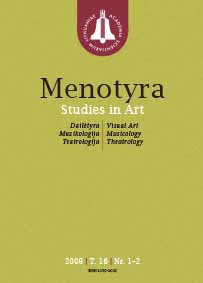Teoriniai šiuolaikinės lietuvių religinės muzikos kontekstai ir perspektyvos
Theoretical contexts and perspectives of contemporary Lithuanian religious music
Author(s): Danutė KalavinskaitėSubject(s): Christian Theology and Religion, Music, Recent History (1900 till today), 19th Century
Published by: Lietuvos mokslų akademijos leidykla
Summary/Abstract: The article deals with the topic of relations – parallels, interfaces and interactions – among religion, Catholic liturgy and music. After Lithuania regained its independence and freedom of religion, discussions of the issues pertaining to the church style, liturgy and religiosity of art started appearing in the press.Within a period of 20 years after the National Revival, Lithuanian composers created a number of religious concert compositions and musical pieces under liturgical titles (Missa, De profundis, Stabat mater, Te Deum, Ave Maria, Litania). Such a multi-coloured and controversial picture of contemporary religious music and the non-functionality of genres of liturgical origin supposedly resulted from the loss of tradition of professional religious art during the years of Lithuania’s occupation, the ignorance of the requirements of the Catholic Church with regard to church music, and the confusion caused by the liturgical renewal initiated by the Second Vatican Ecumenical Council. However, it is also obvious that complications in the relations between Church and church music originated as early as in the 19th century and were followed by internal conflicts of artistic, liturgical and pastoral aspirations in the second half of the 20th century. Like any other contemporary creative work, church compositions have been badly impacted by the processes of globalisation and mixture of cultures.With the view to sound perspectives of religious compositions, both the clergy of the Catholic Church in Lithuania and Lithuanian composers should have better knowledge of the ideas of foreign liturgists, theologists, musicologists and musicians about the possible interactions among religion, liturgy and music, because these opportunities open for contemporary creators the new horizons that are so wide as never before, in their search for the manifestations of spirituality, signs of sacredness and building a new religious / church language by means of their music.
Journal: Menotyra
- Issue Year: 16/2009
- Issue No: 1-2
- Page Range: 50-61
- Page Count: 12
- Language: Lithuanian

